三年级英语上册Unit1 Number教案
- 格式:docx
- 大小:14.40 KB
- 文档页数:6
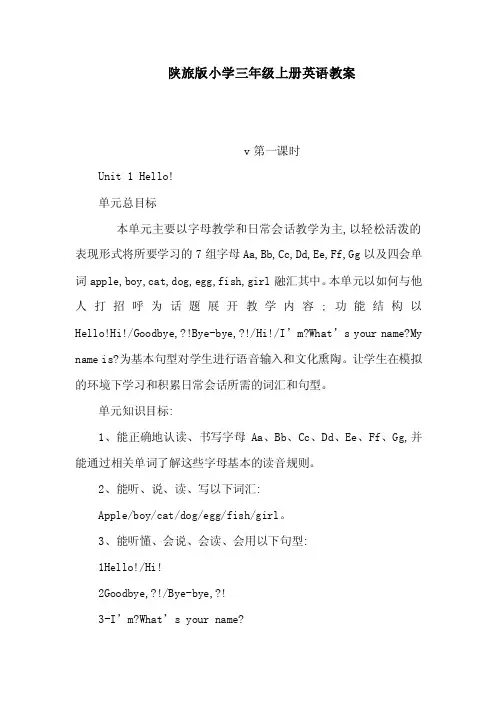
陕旅版小学三年级上册英语教案v第一课时Unit 1 Hello!单元总目标本单元主要以字母教学和日常会话教学为主,以轻松活泼的表现形式将所要学习的7组字母Aa,Bb,Cc,Dd,Ee,Ff,Gg以及四会单词apple,boy,cat,dog,egg,fish,girl融汇其中。
本单元以如何与他人打招呼为话题展开教学内容;功能结构以Hello!Hi!/Goodbye,?!Bye-bye,?!/Hi!/I’m?What’s your name?My name is?为基本句型对学生进行语音输入和文化熏陶。
让学生在模拟的环境下学习和积累日常会话所需的词汇和句型。
单元知识目标:1、能正确地认读、书写字母Aa、Bb、Cc、Dd、Ee、Ff、Gg,并能通过相关单词了解这些字母基本的读音规则。
2、能听、说、读、写以下词汇:Apple/boy/cat/dog/egg/fish/girl。
3、能听懂、会说、会读、会用以下句型:1Hello!/Hi!2Goodbye,?!/Bye-bye,?!3-I’m?What’s your name?-My name is?情感目标:1、帮助学生体会学习英语的乐趣;2、培养学生敢于出口、不怕出错的勇气;3、引导学生积极参与各种课堂活动。
教学内容:Part A Let’s talk(主)Talk in pairsLet’s playListen and match教学目标:1、能听懂、会说Hello!Hi!/Goodbye,?!Bye-bye,?! /-I’m?What’s your name?-My name is?并能在日常生活中灵活运用。
2、能认识课文中出现的人物,如:Liu Zhaoyang,Su Nan等,并能戴上头饰表演。
教学准备:1、教师准备:(1)P3 Listen and match部分的人物卡片以及头饰。
(2)玩具小熊两个,节奏感较强的音乐一段。
2、学生准备:(1)自己喜欢的卡通人物头饰一个。
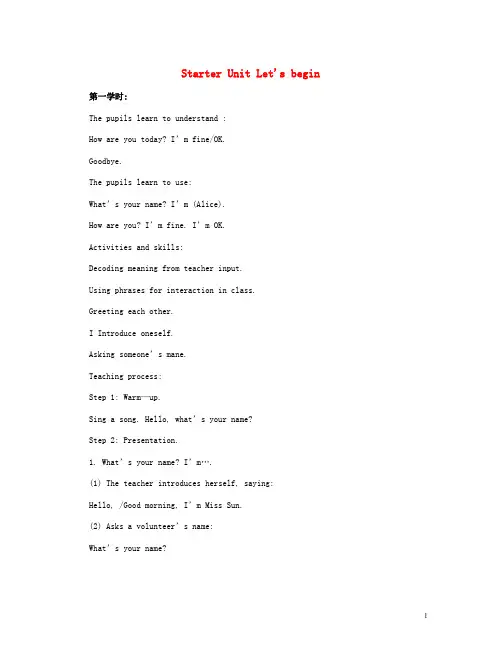
Starter Unit Let's begin 第一学时:The pupils learn to understand :How are you today? I’m fine/OK.Goodbye.The pupils learn to use:What’s your name? I’m (Alice).How are you? I’m fine. I’m OK.Activities and skills:Decoding meaning from teacher input.Using phrases for interaction in class.Greeting each other.I Introduce oneself.Asking someone’s mane.Teaching process:Step 1: Warm—up.Sing a song. Hello, what’s your name?Step 2: Presentation.1. What’s your name? I’m….(1) The teacher introduces herself, saying:Hello, /Good morning, I’m Miss Sun.(2) Asks a volunteer’s name:What’s your name?The teacher prompt the pupil by whispering, I’m (Alice). (3) Asks all the pupils the same question and help those who needit by whisperin g I’m….2. How are you today? I’m fine. I’m OK.(1) The teacher explains the meaning of How are you today? (2) Tell the class to ask the question all together and introducetwo answers, I’m (not very) fine/I’m Ok.(3) Asks all the pupils the same question and make sure that allthe students can reply.Step3: Speak English in class.1.Tells the pupils to open their books at page3, look at the fourphotographs, and listen to the tape.2.Asks the pupils to dramatise the situations depicted in the fourphotographs. A volunteer will play the part of the parts of theother pupils, answering as a group.第二学时:The pupils learn to use these new words:Sandwich, hamburger, hot dog, puller, cowboy, jeans, cinema,walkman, snack bar, Taxi, clown, superstar.Activities and skills:Singing the song and colouring picture frames.Teaching process:Step 1:Warm—up:Greetings:(1) Good morning!(2) I’m Miss Sun. What’s your name?I’m (Alice, John…).(3) How are you today?I’m fine/OK.Step 2:New words.1. Learn to say these words one by one using flash cards.2. Guessing game.Is it a cowboy/snack bar…?No, it isn’t. Yes, it is.3. Read them following teacher.4. Colour the frames.(1)Open book at page4, take your colour pens. Listen and colour.(2)Colour your (hamburger, orange…).(3)Let’s check.The hamburger is orange.Step 3: Sing the song.1. Listen to the tape.2. Teacher sing the words.3. Learn to say the words.4. Let’s sing it one sentence by one sentence.5. Sing the song and do the actions together.Step 4: Say good—bye.Goodbye, children.Goodbye, Miss Sun. See you next time.第三学时:The pupils learn to understand:Watch me. Stretch. Clap your hands. Stand back to back.Stand nose to nose. Stand arm in arm.The pupils learn to use:Good morning./Morning. Good afternoon. Good evening.Good night.Activities and skills:Carrying out action story.Listening to the tape and filling numbers.Teaching process:Step 1: Warm—up(1) Greetings.(2) Play guessing game with flash cards. (3) Sing the song: English is easy.Step 2: Mime the action story.1.The teacher and the pupils listen to the instructions on thecassette. The teacher performs each action and the pupils watchand then imitate the teacher.Repeat this stage several times.2.The teacher gives the instructions in the same order which the pupils heard them on the cassette during Phase 1. The pupilslisten and do the actions one at a time, following the teacher’sinstructions.3.The teacher gives the instructions in jumbled order. The pupilslisten and performs the actions one at a time.Step 3:Listen and fill in the numbers.(1) Listen and mime.(2) Fill in the numbers.(3) Check it. Make sure that everyone is correct.Step 4: Learn to say.The teacher draw a clock on blackboard. When it is 7:30, says“Good morning” or “Morning” to the pupils. The pupils answer “Good morning” or “Morning”.“Good afternoon”, “Good evening” and “Good night” are thesame above.第四学时:The pupils learn to use :How are you? I’m fine/very well/OK.Thank you. And you?Nice to meet you. Nice to meet you, too.Activities and skills:Speaking and comprehension:Teaching process:Step1: Warm—up.1. Greetings.Good morning. /Morning.Good afternoon.2. Sing a song: Join in.Step 2: Let’s read and act.1. T: Hello, I’m Miss Sun. What’s your name?S: Hi, I’m Alice.T: Nice to meet you.Tell the student that he or she should say “Nice to meet you, too.” Have this conversation with others, and make sure that all the pupils can say it correctly.2. Other sentences just to be taught and learnt like those above.3. Actions:(1). Pair work: Two pupils to act the conversations.(2). Boys and girls competition.Step 3: The end.Goodbye, children.Goodbye, Miss Sun.Unit 1 Numbers第一学时:The pupils learn to understand:The tiger jump.Do the numbers rock.The pupils learn to say:Numbers 1—12.Twelve o’clock; do the numbers rock.Yippee!Let’s do the tiger jump.Your turn.Activities and skills:Singing the song: The numbers rock.Saying the chant : The tiger jump.Colouring the numbers.Listening to conversations and matching the names of childrenwith numbers on dice.Playing two number games.Teaching process:Step 1: Warm—up.1. Count numbers from 1 to 10.2. Sing the song. Hop.Step 2: Listen and sing the song. The numbers rock. 1. Learn to say:11 eleven, 12 twelve. Twelve o’clock.2. Listen and say the chant.Step 3: Listen and say the chant.1. The teacher says the chant and performances in the sameorder, the pupils follow.2. Teacher says, pupils do in the same order.3. The teacher says and pupilsdo in the jumbled order. 4. Listen to the tape and say the chant, do the actions.Step 4: Colour the numbers.1. Show numbers’ cards 1—12 to the pupils. Count them.2. Open book at page9, match numbers with the words.3. Colour them and check them.Step 5: Listen and match.1. Teacher writes numbers on the blackboard. The pupils readthem.For example: 3 6, 1 5, 4 5, etc.2. Listen and match then check.3. learn to say “Your turn.”4. Play the game in class.第二学时:The pupils learn to understand:What’s in the box?Guess the number.Super prize!Come on, (Fred).Here is your prize, Emma.Thank you, Emma.Great!The pupils learn to use:What’s in the box?Snails! Yuk!How many?Activities and skills,Listening to and un derstanding a story. Playing game: “Guess the number.” Teaching process:Step 1: Warm—up.1. Say the chant : The tiger jump.2. Sing the song: The numbers rock.Step 2: A game. Guess the number.1. Count numbers 1—12.2. Shows the pupils numbers’ ca rds, guess the number.3. Take a box, put some glass balls in it. Shows them a glassball, asks:What’s this? What’s in the box? How many? If the pupils are right, says “Great! Here is your prize.” And givethem a glass ball.Step 3: A story. The snails.1. Teacher says, You will hear a story. The snails. Please listencarefully.2. Listen to the tape several times.3. Make sure that the pupils fully understand the meaning of thisstory.4. Play this game in class.第三学时:The pupils learn to understand:Guess the number.The pupils learn to use:Twelve is two plus ten, now let’s start again.How many?Yes. / No.Activities and skills:Saying the rhyme.Playing two number games.Teaching process:Step 1: Warm—up.Sing the song. The numbers rock.Step 2: Listen and say the rhyme.1. Count numbers 1—12.2. Read the words line by line several times.3. listen to the tape, say the rhyme.4. Asks a group of 6-7 pupils stand in a circle, and say the rhyme, see who is left out.Step 3: Play a game.1. Teacher asks a pupil to come to the front of the class anddemonstrate the game as shown in the first two pictures.2. Play in pairs and proceed in the same way for the second game.3. Play this game one by one.第四学时:The pupils learn to understand and use:What’s your phone number?Activities and skills:Listening and taking notes of phone numbers and saying whatthey are.Asking other pupils for their phone numbers and taking notes.Teaching process:Step1: Warm—up.1. Count numbers 1—12.2. Say the rhyme.Step 2: Listen and write the phone numbers.1. Draw a big telephone on the board. Introduce the word Phoneor telephone immediately followed by the sentence My phonenumber is ….2. Listen and write.Tell the pupils that they are going to hear some recorded interviews, and that they have to listen and discover the telephonenumbers of a few children.Read the names of the children out loud and ask the pupils torepeat them.Listen to the tape several times and write.3. Let’s check.Step 3: Write your phone numbers.1. The pupils write their phone number. Tell them how to readthe number.2. Read your number yourself.Step 4: Asks children’s phone number.1. Teacher asks, What’s y our phone number? A volunteer answers, other pupils write down.2. Work in pairs.3. The pupils ask and answer each other, and write.4. Let’s check.Teaching aims:1. Learn to say:How many girls/boys/flags…can you see?Let me count. I can see….2. Learn to say:What is (seven) plus (twelve)?What is (eleven) minas (nine)?3. Write the numbers 1—12.Teaching process:Step 1: A game.Prepare a box which is full of glass balls. Shows them the box, and asks, what’s in it? Let pupil guess, and t hen someone touchesit. (Glass balls.)How many? How many glass balls ? How many glass balls canyou see? Count, please. The pupil counts. One, two, three, four…Step 2: Learn to say.1. Teacher chooses a group of pupils, and asks, how many girlscan you see? Tells them to reply, let me count. And then, count.One, two,….Tells them to say, I can see…2. Repeat this exercise several times.3. Ask and answer with other words which they learned, such asboys, flags, dogs…Step 3: Learn to say.1. Write those below on the blackboard:7+5 8+2 11-96+4 12-9 2+2Point a pupil to read them.2. The teacher asks What is 7 plus 5,Make sure that each pupil can reply“It’s…” correctly.3. Pupils open book at page 15, work in pairs.Some pairs of pupils wok in class.Step 4: Complete the word puzzle.1. Show the pupils flashcards of numbers 1—12. Read them, and spell the words.2. Open book at page 15, complete the 14th exercise.3. Check it.Unit 2 Colours第一学时:The pupils learn to understand:What colour is this/The pupils learn to use:Colours: red, orange, yellow, green, blue, purple, pink, black, white.I like (green) and (red); I like orange, too.Oh, what a rainbow!Activities and skills:Listening to words and pointing at the appropriate pictures in the box.Sing a song.Teaching process:Step 1: warm—up.1. Greetings.Good morning. / Good afternoon.2. Sing a song. Butterfly.Step 2: Listen and point—presentation.1. Introduce the following colours: red, orange, yellow, green, blue, purple, pink, white and black.Show the pupils colours with the help of coloured flash cards and objects in the classroom,2. Say the words.(1) Show a colour and say the word several times, then ask the pupils to repeat it.(2) Name a colour and ask the pupils to touch something of that colour.3. A game.(1) Teacher names a colour, four pupils touch an object of the correct colour. The last pupil is “out”. The winner is the person who touches the correct one first.(2) Asks of the pupils to take over the role of the teacher.(3) Proceed in the same way for the other remaining colours.Step 3: Listen and point.Open their book at page 16, listen to the tape carefully, point the corresponding colour.Step 4: Listen and sing s song. Rainbow.1. Draw a picture of a rainbow on the board and introduce the word Rainbow.2. Listen to the word and repeat it.3. Sing the song following the tape.第二学时:The pupils learn to understand:1. What colour is (the wizard’s house)?2. I’m from Italy; (Great Britain; Argentina; Brazil).The pupils learn to use:I’m (Lucia). I’m from China. This is my flag.Activities and skills:Finding out from a lis tening text what colour the wizard’s houseis (listening for detail).第三学时:The pupils learn to understand:Help.Open the door.The pupils learn to use:(Green), please. Here you are.Good night! Good morning!What’s this? Wow!Activities and skills:Listening to and understanding a story.Teaching process:Step 1: Warm—up.1. Sing a song. The rainbow.2. (1) Teacher walks around the classroom asking the pupils:Blue, please. Green, please, etc.The pupils should gives me an coloured pencil requested. (2) Do the same exercise by the pupils in pairs.Step 2: The story.1. Introduce and practise new vocabulary.Here you are. Help. Open the door. What’s this? 2. Pupils listen to the text two or three times with their booksclosed and try to imagine what is happening from the tone of thevoices and blackboard noises.3. Pupils listen two or three times with their books open.4. Pupils listen one more time with their eyes closed and try toimagine what they saw in the text.Step 3: Act out the story.Two pupils for wizards, somebody to make the noises of boilingwater, and explosion, coloured bottles.第四学时:The pupils learn to understand:What’s my favourite colour? Is it (blue)?What’s your favourite colour?Yes, that’s right.The pupils learn to use:Guess.What’s my favourite colour? Is it (blue)?What’s your favourite colour?Yes, that’s ri ght.Activities and skills:Playing a game based on the principle of information gap.Completing dialogues in writing.Listening to a chant and circling patches of colour.Saying a chant.Doing a crossword puzzle.Teaching process:Step 1: Play a guessing game.1. Ask a pupil to touch a part of the coloured fish.The teacher can’t see what colour the pupil is touching and,naming several different colours, should try to guess.2. Once the pupils have understand the way game works, they can play in pairs and exchange roles.Step 2: Complete the dialogues.1. Learn to write the words and sentence:Green, blue, white, please.Here you are.2. Ask the pupils to look carefully at the four scenes and tocomplete the dialogues according to what they see in the pictures.Step 3: A chant.1. The pupils should listen to the chant once all the way through.2. Then they listen a second time, but this time the tape shouldbe stopped after each question to give the pupils time to circle the colour.3. Finally they listen a third time to check the answers.The teacher should check that the pupils have understood and askwhich colours they have circled. The pupils say the colours in the correct order.4. The teacher writes them on the blackboard. The pupils copy the words.5. Repeat the chant in two separate groups.第五学时:The pupils learnt to understand:What about you?What about this?What’s that over there?The pupils learn to use:I’m from (America).I like (red) best.What’s your favourite colour?What colour do you like?Activities and skills:Speaking those sentences in groups.Talking about the birthplace and the favourite colours ofthemselves.Teaching process:Step1: Warm—up1. Say the chant: what’s your favourite colour?2. Revise the words: Great Britain, Italy, Brazil, Argentina. I’m fr om China.Step 2: Let’s learn and work in groups.1. Introduce new words.America, England, Canada, best, about.2. Learn to say.I’m….I’m from….I like (red) best.3. Introduce how to use “what about you?”. Make sure thateveryone has understood it.4. Read the sentences.Step 3: Work in the groups.1. Pair work.2. Teacher and student act in class.3. Work in tablemates as the model.Step 4: Let’s talk.1. Introduce new words: jeep, over there.ing some flashcards, ask and answer. T: What’s this? (A car.)S: It’s a car.T: What colour is it?S: It’s (red).And tell the volunteer to say: It’s a Chinese car. All the classrepeat it.The teacher shows them another flashcard, and asks: What aboutthis?Make sure that the student can answer it correctly. 3. Talk about the flashcards in pairs.4. Let’s talk in class.Unit 3 School things第一学时:The pupils learn to understand:What colour is the wizard’s schoolbag,The pupils learn to use:Pen, pencil, pencil case, schoolbag, ruler, eraser, book..Activities and skills:Listening to the words on the tape and filling in the numbers in the book.Listening to the tape and finding out what colour the wizard’s schoolbag is.Teaching process:Step1: Warm--up.1. Show pupils some school things, such as:pencil, book, pen, schoolbag, pencil case. Ask pupils: What’s this? It’s a (pen).2.A game Toby says:Touch your (pen). Take your (book).Step2: Listen and fill in the numbers.1. Introduce the new vocabulary using realia, rule, eraser,2. The pupils open their books at Page 24.The teacher reads the words, first in the order in which they are presented and then in jumbled order, ask the pupils to point to the corresponding picture.3. Listen and fill in the numbers.(1) The first time, the pupils listen to the tape without interruptions for general do the exercise by themselves.(2) The second time, the pupils listen to the tape without interruptions so that everybody can do the exercise.Check the answer. Name the objects and ask the pupils to answerwith the corresponding numbers.Step3. Listen. What colour is the wizards schoolbag.1.Tell the pupils in Chinese that they have to discover the colour of the wizards schoolbag.2.Give them an example.The pupils point to the word start, the teacher says blue and the pupils pointto the blue square. Then say ruder and the pupils touch the ruder.Proceed in this way from ruder to yellow, and then to pencil to blue to eraser.At this point ask What colour is the wizards schoolbag? (Blue).3.Listen to the tape and follow the sequence of squares using a pencil.4.Listen two or three times to check the answer.第二学时:The pupils learn to understand:Open your (schoolbag).Take out (a ruler).Take out (two books).W hat’s this? A skipping rope.Hooray!The pupils learn to use:Three pens, four pencils, two books.Activities and skills:Understanding instructions and miming actions.Listening to the tape and filling in numbers.Teaching process:Step 1: Warm—up.Ask and answer.Show the pupils a ruler, a pen ,a schoolbag, two erasers, four books, three pencils.Ask: What’s this? What colour is it? How many books can yousee? Etc.Step 2: New word.Show them a skipping rope and teach the new word.Step 3: Mime the action story.1.The teacher and the pupils listen to the instructions on the cassette. The teacher performs each action and the pupils watch and then imitate the teacher.Repeat this stage several times.2.The teacher gives the instructions in the same order which the pupils heard them on the cassette during Phase 1. The pupils listen and do the actions one at a time, following the teacher’s instructions.3.The teacher gives the instructions in jumbled order. The pupils listen and performs the actions one at a time.Step 4:Listen and fill in the numbers.(4) Listen and mime.(5) Fill in the numbers.(6) Check it. Make sure that everyone is correct.第三学时:The pupils learn to understand:How many (red) things are there?The pupils learn to use:Two pens, three erasers, four pens, five rulers.Activities and skills:Reading what is in the picture and colour frames around word groups in the appropriate colour.Counting school things in a picture puzzle.Teaching process:Step1: Warm—up.A guessing game.1. Show the pupils a box which is full of pens, pencils, rulers, erasers, and books. And ask the pupils to guess how many pens/ pencils/ rulers/erasers/books are there?T: Guess! How many (pens)?2. When the pupils guess correctly, ask them: What colou arethe (two pens)?Step 2: Read and colour the frames.1. Introduce how to do the exercise.Point out to the pupils that there are 10 pictures and only five boxes on the right. The pupils have to colour the frames of the boxes on the right following the example. The frame of the box containing the words two pens, is orange like the two pens in the drawing.2. The pupils colour the frames themselves.3. Check the answer.Ask the pupils to say which colours match which words.Step3: Count and write the numbers.1. Read the sentences several times. And translate the questions.2. Thepupils write exercise in the book.3. Check the answer.Ask the question and the pupils answer orally.第四课时 :Teaching aim And demand:1.The pupils learn to understand:Stop it.Come here, Timmy.Help me, please.Where’s my pencil case?It’s not here.I’ve got it!2.Acticities and skills:Decoding the meaning of the language in a story. Important and Difficult front: Understand the sentences of the story.Teaching process:Step 1:Warming-up1.Sing an English song: Join in.2.Revise the school thing. Which have learnt in this unit.3.Revise the sentence: Here is your prize. Here is my prize.Step 2 : Presentation1.Listen to the story.2.Ask the students to open their books at page 28.3.Ask them listen to the tape, listen to an English story.4.Ask the students to tell the meaning of the story.Step 3 : Learn to understand the sentences.1.Ask some students do a action, then say: Stop it, xxx.” Let the students tell the meaning of the sentence. Then practise it.2.Pretend to find something, and say: Where’s my pen?” Ask the students to say what am I doing. And tell the meaning of the sentence.3.Ask someone xxx, help me, please.” Let him/her find things with me. Then ask them to tell the meaning of the sentence.4.Practise the two Sentences in pairs.5.Say:It’s not here,” while finding the thing. Let them say the meaning of the sentence. Then practise it.6.Wh en finding the thing, say: I’ve got it!” Let the students tell the meaning of the sentence. then practise to say it.Step 4 : Consolidation1.Listen again and say the sentences after the tape.2.Perform the story in the class.第五学时 :Teaching aim And demand:1.The pupils learn to use:How many desks are there?What about Chairs?How many pens have you got?2.Activities and skills:Let’s read.Let’s work in groups.Important and difficult point: Read the conversation.Teaching process:Step 1 : Revision1.Sing an English song: In our classroom.2.Show some pictures to the students and ask them to read it. (desks). (chairs).3.Revise the colours.4.Revise the sentences. Which they have leamed in previous class.5.Spell the words.Step 2 : PresentationA: Learn to say the conversation.1.Show a picture to the students.2.Ask them How many desks are there”?3.Ask: What about Chairs? How many charis are there?”4.Show some other things to the student, practise to the sentence Howmany(desks) are there?”5.Read the conversation to the students, ask them to tell me the meaning of the conversation.6.Read the conversation after the teacher several times. Then practise by themselves in pairs, until they can read it correctly.7.Ask someone to perform the conversation in the front of the classroom.Step 3 : Play a game and do the group work.1.Send something to the students.2.Ask them one by one: How many pens have you got?” Answer the question in stead of the students. Then ask them to tell me the meaning of the sentence.3.Ask them to read the sentence after the teacher several times.4.Practise the sentence by themselves, until they can read itcorrectly.5.Do the group work.第六学时 (12. Revision)Teaching aim And demand:1.The pupils learn to read the sentences:I have got (a small room).It’s (nice) and (clean).There is (a bed) (in my room).There is (a computer) (on the desk).I often work at the desk.2.Activitise and skills: Read the text.Important and difficult point:Can read the text of the lesson.Teaching process:Step 1 :Revision1.Sing an English song.2.Spell and read the words:pencil, pencil case, pen, book, eraser, ruler, schoolbag. 3.Look the pictures and say.Two pencils two blue pencils ect.5.Ask and answer:How many pencils are there?How many blue things are there?How many pens have you got?Step 2 :PresentationA : Look at the pictures, learn to say the new words. 1.Point the thing and say the English of it.2.Ask the students to read the word after the teacher. (bedcomputer)3.Practise to say the words by themselves, and then say outloudly, until they can red it correctly.B : Look at the picture again. Ask and answer:Where is the (bed),1.Ask the students to look at the picture and answer: Where is thebed?2.Answer in stead of the students: It’s in the room.e the same way to teach:It’s by the window.It’s on the desk.Step 3: Learn to say the text.1.Look at the picture and listen to the teacher read the text.2.Ask them to tell the meaning of the text.3.Read the text after the teacher several times.4.Practise to read the text by themselves, until they can read itcorrectly.5.Ask someone to point the picture and say the text.Unit 4 Pets第一学时:Teaching aim And demand:1.The pupils learn to use:What have you got?Have you got a pet? Yes, I have.2.Learn to use the words:Cat dog mouse fish budgie, rabbit. Hamster.3.Activitise and skills:Saying a chantListening to a cass ette and finding out what the wizard’s pet is. Important and difficult point:pictures, radio and tape.Teaching process:REVISION:1.Sing an English song: join in.2.Conversation:What’s your favourite colour?What colour is the schoolbag? ect.PRESENTATION:A: Learn to say the six new words.1.Learn to say the word: cat.Show a picture of a cat to the stuelerts, tell them: This is a cat.” Ask them to read the word after the teacher several times. Thenpractise by themselves, until they can read the word correctly.e the same way to teach the other words: dog, mouse, fish,budgie, rabbit.3.Fun time.Listen to the sound of these animals or mine these animals. Askthe students to say the words and at the same time point to thecorresponding flashcard.B: Learn to say the sentences.1.Learn to say the sentence: Have you got a pet?Pretend to need a pen and ask a pupil: Have you got a pen? Ifnecessary translate the sentence.2.Read the sentence after the teacher several times.3.Practise the sentence by themselves:Use the flashcard and ask the students:Have you got a (hamster)? And then answer “Yes.” And thenask the students to ask the teacher answer.e the same way to teach:What have you got?C: Listen and say the chant.Play the chant two or three times and ask the pupils to repeat it, until they can read it correctly.D: Listen and find the wizard’s pet.Ask the same way before.BLACKBOARD DESIGN:PetsCat dog mouseFish budgiz rabbitHamster.第二学时 :Teaching aim And demand:1.The pupils learnt to use the sentence:(Linda)’s cat is brown and white.。
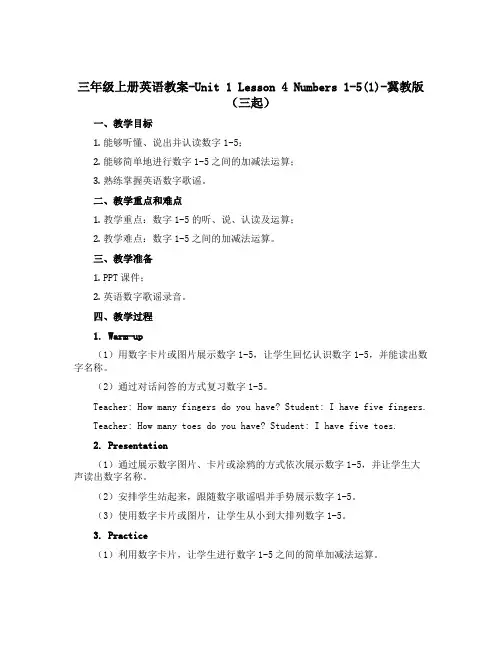
三年级上册英语教案-Unit 1 Lesson 4 Numbers 1-5(1)-冀教版(三起)一、教学目标1.能够听懂、说出并认读数字1-5;2.能够简单地进行数字1-5之间的加减法运算;3.熟练掌握英语数字歌谣。
二、教学重点和难点1.教学重点:数字1-5的听、说、认读及运算;2.教学难点:数字1-5之间的加减法运算。
三、教学准备1.PPT课件;2.英语数字歌谣录音。
四、教学过程1. Warm-up(1)用数字卡片或图片展示数字1-5,让学生回忆认识数字1-5,并能读出数字名称。
(2)通过对话问答的方式复习数字1-5。
Teacher: How many fingers do you have? Student: I have five fingers.Teacher: How many toes do you have? Student: I have five toes.2. Presentation(1)通过展示数字图片、卡片或涂鸦的方式依次展示数字1-5,并让学生大声读出数字名称。
(2)安排学生站起来,跟随数字歌谣唱并手势展示数字1-5。
(3)使用数字卡片或图片,让学生从小到大排列数字1-5。
3. Practice(1)利用数字卡片,让学生进行数字1-5之间的简单加减法运算。
(2)安排学生小组合作活动,将数字卡片随机发放到每一组,让学生快速将自己手中的数字卡片按照1-5的顺序排列好。
4. Production(1)让学生在纸上操作小游戏,练习数字1-5之间的简单加减法,或写下数字歌谣的谱曲。
(2)邀请部分学生在班前表演数字歌谣并展示数字卡片排列情况,其他学生可以进行打分或给予点评。
5. Homework(1)简单的练笔作业:让学生在家练习数字1-5的写法,并将五个数字的写法截图打印在纸张上。
(2)任务型作业:让学生在家精心制作一张数字1-5的彩绘作品,并于下节课时展示。
五、教学反思本课教学内容简单易懂,符合学生认知心理,也协助开发学生数学智力。
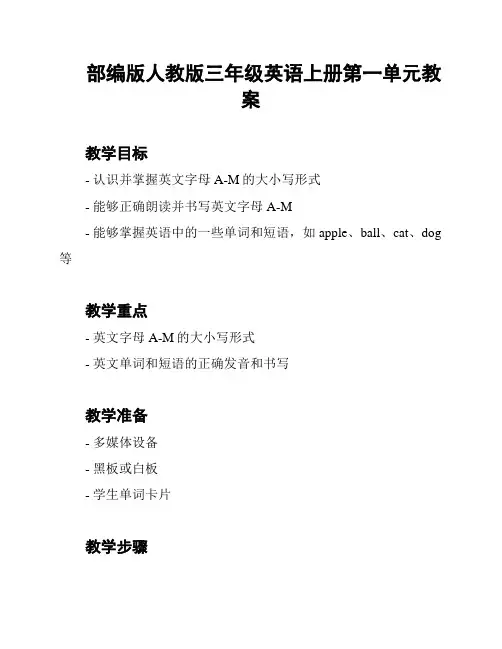
部编版人教版三年级英语上册第一单元教案教学目标- 认识并掌握英文字母A-M的大小写形式- 能够正确朗读并书写英文字母A-M- 能够掌握英语中的一些单词和短语,如apple、ball、cat、dog 等教学重点- 英文字母A-M的大小写形式- 英文单词和短语的正确发音和书写教学准备- 多媒体设备- 黑板或白板- 学生单词卡片教学步骤1. 导入新课:向学生展示字母A-M的大小写形式,用手指指向每个字母,让学生一起跟读。
2. 向学生介绍英文字母A-M的发音,鼓励学生模仿发音,并重复几次以加深记忆。
3. 制作字母卡片:将字母A-M的大写形式写在一张张卡片上,张贴在教室的墙上。
4. 分发学生单词卡片:将包含以字母A-M开头的单词或短语的卡片分发给每个学生。
让学生用英语念出自己卡片上的单词,并组成句子来描述这些单词。
5. 练朗读和书写:让学生在黑板或白板上写出字母A-M的大小写形式,并朗读出来。
6. 小组活动:将学生分成小组,让他们用字母卡片拼出单词。
每个小组选一个代表来分享他们拼出的单词。
7. 游戏时间:进行一个以字母A-M为主题的英语连连看游戏,让学生通过游戏巩固字母的认识和发音。
8. 总结:与学生一起回顾并复本节课学到的内容,强调字母A-M的大小写形式和相关单词的发音和书写。
教学延伸- 教师可在课后布置字母A-M的书写作业,鼓励学生每天复并巩固所学内容。
- 可以引导学生通过阅读绘本或英文儿歌来进一步练字母的认识和发音。
教学评估- 在课堂上观察学生的积极参与程度和发音准确性。
- 收集学生的作业并进行评分,评估他们对字母A-M的掌握程度。
参考资料《部编版人教版三年级英语上册》教材。
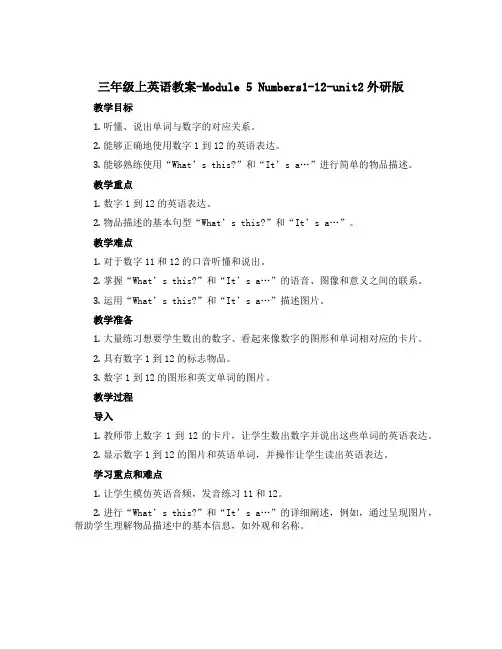
三年级上英语教案-Module 5 Numbers1-12-unit2外研版教学目标1.听懂、说出单词与数字的对应关系。
2.能够正确地使用数字1到12的英语表达。
3.能够熟练使用“What’s this?”和“It’s a…”进行简单的物品描述。
教学重点1.数字1到12的英语表达。
2.物品描述的基本句型“What’s this?”和“It’s a…”。
教学难点1.对于数字11和12的口音听懂和说出。
2.掌握“What’s this?”和“It’s a…”的语音、图像和意义之间的联系。
3.运用“What’s this?”和“It’s a…”描述图片。
教学准备1.大量练习想要学生数出的数字、看起来像数字的图形和单词相对应的卡片。
2.具有数字1到12的标志物品。
3.数字1到12的图形和英文单词的图片。
教学过程导入1.教师带上数字1到12的卡片,让学生数出数字并说出这些单词的英语表达。
2.显示数字1到12的图片和英语单词,并操作让学生读出英语表达。
学习重点和难点1.让学生模仿英语音频,发音练习11和12。
2.进行“What’s this?”和“It’s a…”的详细阐述,例如,通过呈现图片,帮助学生理解物品描述中的基本信息,如外观和名称。
练习1.给学生分发标志物品(例如一个桶或一个坐垫),要求学生在回答问题时对该物品使用“What’s this?”和“It’s a…”句型。
教师可以鼓励学生找到更多物品进行练习。
2.游戏时间:教师将所有练习过的数字/单词卡片随机放置在桌面上,比赛时间设置10分钟,每次学生要从桌面中挑选数字/单词卡片并在尽可能短的时间内无错误读出。
结束1.要求学生对于“可以说出多少数字?”进行总结和回答。
教学评估1.通过学生在班级中的表现来评估他们在此单元的水平。
2.看他们是否能够准确地读出数字,是否能够对物品进行相应描述,以及描述的准确性如何。
教学延伸1.鼓励学生在家里继续进行数字的练习,通过表演游戏和日常对话巩固所学词汇。
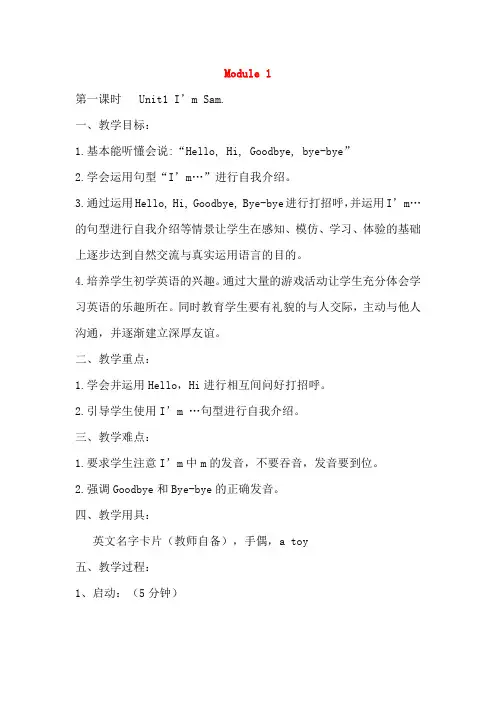
Module 1第一课时 Unit1 I’m Sam.一、教学目标:1.基本能听懂会说:“Hello, Hi, Goodbye, bye-bye”2.学会运用句型“I’m…”进行自我介绍。
3.通过运用Hello, Hi, Goodbye, Bye-bye进行打招呼,并运用I’m…的句型进行自我介绍等情景让学生在感知、模仿、学习、体验的基础上逐步达到自然交流与真实运用语言的目的。
4.培养学生初学英语的兴趣。
通过大量的游戏活动让学生充分体会学习英语的乐趣所在。
同时教育学生要有礼貌的与人交际,主动与他人沟通,并逐渐建立深厚友谊。
二、教学重点:1.学会并运用Hello,Hi进行相互间问好打招呼。
2.引导学生使用I’m …句型进行自我介绍。
三、教学难点:1.要求学生注意I’m中m的发音,不要吞音,发音要到位。
2.强调Goodbye和Bye-bye的正确发音。
四、教学用具:英文名字卡片(教师自备),手偶,a toy五、教学过程:1、启动:(5分钟)(1)课前播放学生熟悉的英文儿歌Hello 或字母歌渲染课堂学习的活跃气氛。
(2)教师可以在课前收集一些常用的英文单词或缩略语如:WTO TV,CD,KFC,Best Food让学生了解一些身边的英语,同时也请同学们说一说他们所知道的生活中的英语,这样有助于强化他们亲身经历英语的真实感受。
2、导入:(3分钟)启发学生当他们在新学期初次见面的时候,他们是如何相互间有礼貌的打招呼问好的呢?当他们在彼此陌生的情况下,是如何相互作自我介绍,互相交流的呢?教师用语:新学期开始了,老师首先欢迎各位新同学的到来,虽然同学们都来自不同的地方,但现在我们就是一家人,那你愿意用自己最友好的方式相互问候和作自我介绍吗?3.呈现:(12分钟)(1)教师首先以自然的方式配以恰当的手势动作和不同的语调来向学生问好Hello , Hi。
同时也引导学生向教师说Hello , Hi 。
然后让学生相互间用Hello, Hi 练习问好。
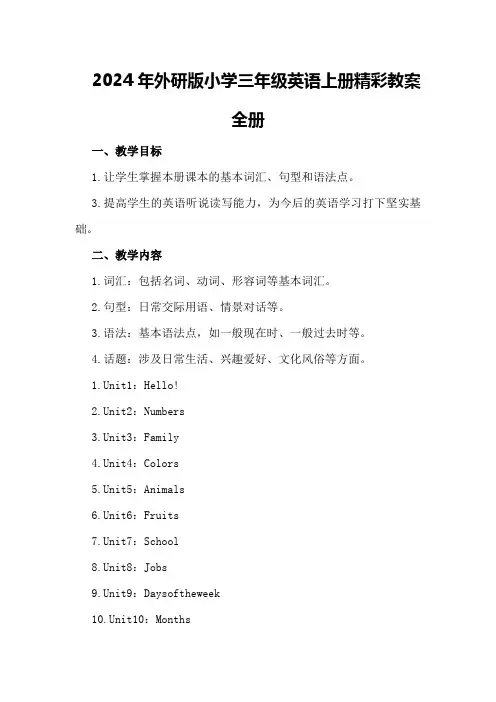
2024年外研版小学三年级英语上册精彩教案全册一、教学目标1.让学生掌握本册课本的基本词汇、句型和语法点。
3.提高学生的英语听说读写能力,为今后的英语学习打下坚实基础。
二、教学内容1.词汇:包括名词、动词、形容词等基本词汇。
2.句型:日常交际用语、情景对话等。
3.语法:基本语法点,如一般现在时、一般过去时等。
4.话题:涉及日常生活、兴趣爱好、文化风俗等方面。
1.Unit1:Hello!2.Unit2:Numbers3.Unit3:Family4.Unit4:Colors5.Unit5:Animals6.Unit6:Fruits7.Unit7:School8.Unit8:Jobs9.Unit9:Daysoftheweek10.Unit10:Months11.Unit11:Seasons12.Unit12:Holidays三、教学策略1.情境教学:利用实物、图片、动作等,为学生创设真实的语言环境,让学生在情境中自然地学习英语。
2.互动教学:鼓励学生积极参与课堂活动,与他人合作,提高口语表达能力。
3.激励评价:对学生进行正面评价,激发他们的学习兴趣和自信心。
4.分层次教学:根据学生的学习程度,进行有针对性的教学。
Unit1:Hello!教学目标:1.让学生掌握单词:hello,hi,howareyou,fine,thankyou等。
2.让学生学会用“Hello/Hi”和“Goode”与人打招呼。
教学步骤:1.导入:教师与学生用中文打招呼,引导学生用英语回应。
2.新课:教师展示图片,教授单词和句型。
3.练习:学生两两练习,互相用英语打招呼。
4.作业:用英语给家人或朋友写一封问候信。
Unit2:Numbers教学目标:1.让学生掌握数字1-10的英语表达。
2.让学生学会用英语数数。
教学步骤:1.导入:教师出示数字卡片,引导学生用中文说出数字。
2.新课:教师教授数字1-10的英语表达。
3.练习:学生分组数数,比一比谁数得快。
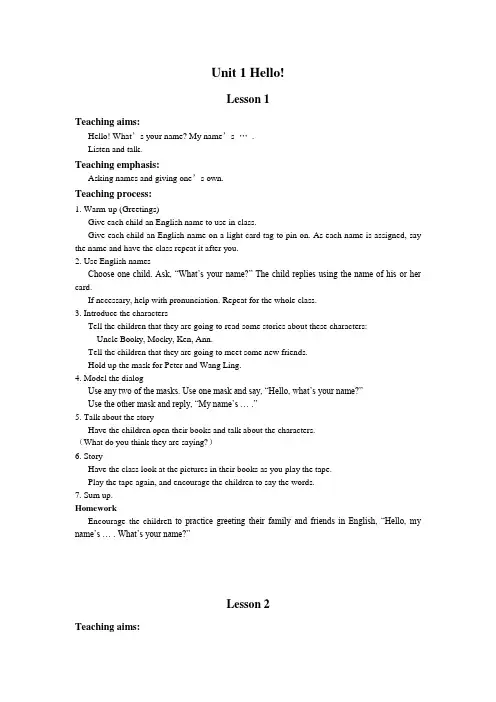
Unit 1 Hello!Lesson 1Teaching aims:Hello! What’s your name? My name’s ….Listen and talk.Teaching emphasis:Asking names and giving one’s own.Teaching process:1. Warm-up (Greetings)Give each child an English name to use in class.Give each child an English name on a light card tag to pin on. As each name is assigned, say the name and have the class repeat it after you.2. Use English namesChoose one child. Ask, “What’s your name?” The child replies using the name of his or her card.If necessary, help with pronunciation. Repeat for the whole class.3. Introduce the charactersTell the children that they are going to read some stories about these characters:Uncle Booky, Mocky, Ken, Ann.Tell the children that they are going to meet some new friends.Hold up the mask for Peter and Wang Ling.4. Model the dialogUse any two of the masks. Use one mask and say, “Hello, what’s your name?”Use the other mask and reply, “My name’s … .”5. Talk about the storyHave the children open their books and talk about the characters.(What do you think they are saying?)6. StoryHave the class look at the pictures in their books as you play the tape.Play the tape again, and encourage the children to say the words.7. Sum up.HomeworkEncourage the childre n to practice greeting their family and friends in English, “Hello, my name’s … . What’s your name?”Lesson 2Teaching aims:Hello! What’s your name? My name’s ….Listen, say, talk and sing.Teaching emphasis:Asking names and giving one’s own.Teaching process:1. Review English namesSay, “Hello! What’s your name?” Encourage children to reply in turn,“My name’s … .”2. Review the characters with the masks.Ask, “What’s your name?” The children choose one character and then reply,“My name’s … .”Repeat with all the character masks.3. Learn to sayHave the class look at the picture at the top of the page.As you play the tape, have the class point to the character that is speaking.Replay the tape while displaying your copy of the page.As the tape is played, point to the words one at a time.Without the tape, read the words together. Have the children touch each word as they say it.4. Listen to thisPoint to each picture and ask, “Look at the picture, Who is saying?”Elicit children say out the right answer.Play the tape and have the children number each picture.Listen again and check the answer.5. Let’s singRead the words to the children, pointing to each word.Play the first six lines of the song, encourage the children touch the words in their books as their sing along.Play the last two lines of the song. Ask the children to sing these lines using their own English names.Try to sing along with the tape.Lesson 3Teaching aims:Hello! What’s your name? My name’s ….Listen, talk and read.Teaching emphasis:The correct writing of each letterTeaching process:1. Warm-upSing the song along with the tape.2. Talk togetherUsing the structures, review each child’s English name.Using the masks, review the structures in a speech chain.Ask and answer one by one.Have each child turn to the top of page 6 and display the page and model the dialog, pointing to the matching character as you speak.Organize a speech chain, where children substitute their English names for those that are underlined.3. Listen and numberI ntroduce the characters to children first.Explain that you want them to listen to the tape and touch the correct characters when they hear them say,“Hello!”Play the tape again, have them write the number of the sentence in the box beside each picture.Check the answer.4. Touch and sayDraw the children’s attention to the bottom part of page 9. Display your copy of the page, and explain that when you point to a character you will ask a child to tell the c lass what that character would say.If time allows, children could repeat the activity in pairs or small groups.5. Uncle Booky’s BlackboardHold up the What’s your name? Drill card and read it to the children point to the words as you read them.Have the children repeat the question after you.Now hold up the What is your name? Drill card and repeat the procedure. Explain that both structures mean the same thing.Point to the ’s of What’s and explain that the apostrophe mark shows that a letter has been left out.In the same way, review My name’s and My name is.Now have the children open their books at the top of page 9.Model the structures by reading.6. Read, match and colorReview the structure Hello! My name’s … . Using masks and name cards.Ask the children to practice reading sentences like My name’s … by using drill cards.Ask children to read the sentences in the 4 speech bubbles and match them with the characters who have said them. Ask children to draw a line between the speech bubbles and characters.7. Divide the class into two groups. Have one group repeat the questions, and the other groups repeat the answers. Use all possible combinations.8. Sum upHomeworkColor the pictures and letters for Aa, Bb, Cc, Dd at page 7.Lesson 4Teaching aims:Hello! What’s your name? My name’s ….(Phonics and writing)Aa Bb Cc DdListen, chant and write.Teaching emphasis:The correct writing of each letterTeaching process:1. Check the children’s work for last period.2. Sing the song.3. Introduce the letter Aa, Bb, Cc, Dd.Display your copy of the page. Draw the children’s attention t the pictu re of the thing beginning with Aa.Play the tape, pointing to the matching picture of the word.Replay the tape and have the children say the words aloud.Repeat the procedure for letters Bb, Cc, Dd.4. Uncle Booky’s ABCHave the children turn to the black and white copy of Uncle Booky’s ABC. They can trace over the letters Aa, Bb, Cc, Dd and color the picture.5. Listen for the letters.Draw the children’s attention to the pictures at the bottom half of page 8.Display your page. Point to each picture in turn and say the matching word.Now play the tape. As the children repeat each word they should point to its beginning letter.6. Write the letters.Say, “Watch me write the letter A.” Stand with your back to the class. Write capital letter A in the air, using large arm movements. Ask the children write the letter in the air with you.Repeat for the small letter a.Have the children trace and copy the letter Aa.Walk around the classroom and check the children’s work.Follow the same procedure for Bb, Cc, Dd.Tell the children that they will finish tracing over the letters for homework.7. Sum up for the structures and the letters.Lesson 5Teaching aims:Hello! What’s your name? My name’s ….Listen, read and write.Teaching emphasis:Use the structures in communicationTeaching process:1Let’s chantUse the flash cards and have children practice reading these words.Read the rhyme to the children, pointing to each word.Play the tape for the whole rhyme and have children listen and point to the words on the page.Play the tape again and have children join in, encouraging them to hum or clap with the rhythm.Put pictures of dog, cat, ball and apple on the blackboard. Ask children to point to these pictures when listening to the tape again or they can add some actions and act the rhyme out.2. Clap namesIn this activity the children practice sounding out the separate syllables in their English names.Model the children’s English names for them. As you say each name aloud, clap your hands together once for each syllable. For example: My name’s David. (Two claps.)Have the children repeat all their names after you, clapping as they do so.Start a speech chain, so that the children can each ask the question and sound out their names individually.If time allows, repeat the procedure, substituting the names of the characters in this book.Lesson 6Teaching aims:Wake up! One for you. One for me.Listen, read and write.Teaching emphasis:Consolidate the structures and vocabulary learned in this unitTeaching process:1. Uncle Booky’s Story timeTell the children that they are going to listen to a story.Play the tape, ask the children to listen to the story with their books closed.Have the children open their books, and look at the pictures.Ask them to look for familiar words in the story.Have children read the story silently, encourage them to try to guess the meaning of unfamiliar words.It doesn’t matter if they don’t know the words. The requ irement for this part is to understand the story.2. BingoThis is a vocabulary drill in the form of a game.Photocopy a Bingo Game board 1 for each child.The teacher calls out the different character names/words and the children find the correct picture in their game board. (make sure that you call out the names/words in a random order)The children circle the word or letter (in pencil)when they hear the teacher call it out.The children call out “Bingo!” each time they have circled a full column down th eir Bingo boards.At the end of the game, review all the vocabulary in a class drill.3. Self-assessmentHave the children do this part in pairs or in groups by themselves.Children should assess themselves according to their own situation.They should be encouraged to compare their results with and learn from each other.Students work in pairs in the first activity, practicing introducing themselves.For the second activity, have children group the words beginning with the same letter together and say them aloud.4. Conclude for this unit.UNIT 2 This is Danny DeerLesson 1Teaching Aims:1.he student can be understand the dialogue what’s mean.2.The students like to learn English.3.The students can be read the dialogue.Teaching Emphasis:1. Review: How can use “What’s your name?” in dialogue. And answer it.2. Emphasis sentence: This is…. This isn’t….Teaching Difficulty:How can use “This is….” ”This isn’t….” in dialogue.Teaching Medium:Step 1:1. Hold up mask for Lulu. Say, “This is Lulu.”2.Have the children say Lulu. Repeat this for Danny.3.Repeat several times, and have the children say the names.Step 2:T: Hold up mask for Mocky and say, “This is Mocky.” Have the children repeat the sentence after me.Repeat the procedure for all the other masks.Hold up each of the masks in turn, and say, “This is …”S: Make it.At last, hold up a mask but say nothing. Have the children make a sentence of their own.Step 3:T: Say, “stand up.” As you say this, s tand up. Then have the children stand up.Repeat the procedure for Sit down.S: Let the children stand up and sit down in response.T: Repeat the procedure for Open your books. And Show me a pencil.Step 4:Open the books.T: Ask these questions about the pictures:Picture 1: Who can you see in the picture?What are they doing?What do you think they are talking about?Picture 3: What are Ann, Ken and Mocky doing?Picture 4/5: Who do they meet?Picture 6/7: Do they like him?Picture 8: Who does Mocky see?Picture 9: How does Mocky feel?Picture 10: Has Mocky made a mistake?Picture 11: What is happening to Mocky?Step 5:Story: The students read after the tape.Explain that people often say” Oh, no.” ”Come on!” “Super”Homework:Explain that you want the class to tell their families about the new characters, Danny and Lulu.Lesson 2Teaching Aims:1.Understand the dialogue what’s mean.2.The students like to learn English.3.The students can be read the dialogue very expertly.Teaching Emphasis:1. Review: How can use “What’s your name?” very expertly in dialogue. And answer it.2. Emphasis sentence: This is…. This isn’t….Teaching Difficulty:How can use “This is….” ”This isn’t….”very expertly.Teaching Medium:Step 1:Review: “Hello! What’s your name?”“ My name is …”Step 2:T: “This is … “ “This isn’t …”S: Introduce your good friend’s name each other.Step 3:T: Touch a book in the classroom. Make sure all the children can see it. Say, “A book.”Repeat for a pen.Play the tape and touch each object as you hear the words.S: Have the children look at the pictures at the top of page 16.Step 4:T: Show me a pencil and so on.S: Show itStep 5:T: What is this?S: This is a book and so on.Step 6:Play games:Have the children open their books at page 17. Drew their attention to the box at the top of the page.Point to each of the object in turn, naming them in English as you do so.Look at the picture; ask each pair in turn to give the English word for a missing object.Lesson 3Teaching Aims:1.se the dialogues explain the mind.2.Keep the students like to learn English.3.The students can be introduced these good friends.Teaching Emphasis:1. Review: How can use “What’s your name?”in live. And answer it.2. Emphasis sentence: This is…. This isn’t….Teaching Difficulty:How can use “This is….” ”This isn’t….” in live.Teaching Medium:Step 1:Introduce your good friend’s name each other.Step 2:Student book page 18:Say to the children: “Open your books.”Display your copy of the page. Read the words slowly, pointing to each word as you say it. Substitute two of the children’s English names for the underlined names in the text.Step 3:Listen and number:T: Display your copy of the page.Point to the picture of Danny Deer..Say, “This is Danny Deer.”S: Have the children repeat the words as they point to the picture in their books.Repeat another people.T: play the tape. Touch the correct picture as you hear the words.S: Explain that you want them to write the number of the sentence in the box beside each picture as they listen to the tape.Step 4:Review the second letter: a, b, c, d.Learn the new letter: e, f, g, h, i.Replay the tape, and have the children point to the matching pictures in their book.S: replay the tape and have the children say the word aloud.Step 5:Repeat the procedure that was used to introduce the letter Ee and the word eggs.Homework:Have the children open their books at page 19. Explain that you want them to: Color all the Ee letters in one colorColor letters Ff, Gg, Hh, Ii in different colors.Lesson 4Teaching Aims:e the dialogues explain the mind.2.The students like to learn English.3.The students can be expertly introduced these good friends.Teaching Emphasis:1. Re view: How can use “What’s your name?” expertly in live. And answer it.2. Emphasis sentence: This is…. This isn’t….Teaching Difficulty:How can use “This is….” ”This isn’t….” expertly in live.Teaching Medium:Step 1:Write the letter Ee-Ii:Student book page 20T: Stand with my back to the class.Write capital letter E in the air, using large arm movements.Ask the children to write the letter in the air with you.S: Learn the teacher’s.T: Repeat for the small letter e.And another letters.S: Go on doing that.T: Tell the children that they will finish tracing over the letters.S: Write the letters.Step 2:Student book page 20Listen for E-I:T: Draw the children’s attention to the pictures on the bottom half of the page.Display you copy of the page.S: Open the book and do it.T: Show the pictures for teaching.Say the matching word, for Example: elephant.S: Read after the teacher.T: Now play the tape.S: Read after the tape and should point to beginning letter.Step 3:T: Show the pictures.Stop the tape.S: Have the children point to each picture in turn and say the beginning sound. Step 4:Student book page 21T: Hold up the This is drill card and read it to the childrenPointing to the words as you read them.S: Read.T: Repeat the procedure with the Danny drill card.S: Read and think it.T: Use another mask for drills such as: Monkey, Booky and so on.S: Make it.Step 5:T: Hold up the This is not drill card and read it to the childrenPointing to the words as you read them.S: Read.T: Repeat the procedure with the Danny drill card; say, “this is Monkey”.S: Read and think it.T: Use another mask for drills such as: Monkey, Booky and so on.S: Make it.Homework:Remind the class of the work they began earlier, tracing and writing the letters.color the pictures on page 20.Lesson 5Teaching Aims:1. Understand the sentence how can use.2. The students like to learn English.3. The students can be very expertly introduced these good friends.Teaching Emphasis:1. The letters.2. Emphasis sentence: This is…. This isn’t….Teaching Difficulty:How can use “This is….” ”This isn’t….” very expertly in live.Teaching Medium:Step 1:Match the names:Student book page 22T: Ask children to say the names of the characters in the picture.If I point at one character and ask children to say its name.S: Answer it.Then color the characters.Step 2:Sing a song:<<When you are happy>>T: Tape 1-2S: sing after the tape.I think the children will enjoy learning this song.T: Repeat the tape.S: sing it again.Step 3:Let’s chant:Student book page 23T: Show the picture for new words.S: Repeat the new words.T: Make sure the children can say these things when given a picture or a real object.Tell the children that they are going to learn a rhyme about a naughty elephant.Play the tape for that.S: The children like to learn that.T: Play the tape.S: read after the tape again and have themselves join in, encouraging them to hum or clap with the rhythm.T and S:Have children point to the pictures in their books as they listen to tape again or they can add some actions and act the rhyme out.Step 4:Homework:1. Color the picture on page 22.2. Sing the song or the rhyme to their families.Lesson 6Teaching Aims:1. Use the sentence is very expertly and read the dialogue.2. The students like to learn English.3. The students can be very expert introduced these friends.Teaching Emphasis:1. The letters.2. Emphasis sentence: This is…. This isn’t…. very expert in live.Teaching Difficulty:How can use “This is….” ”This isn’t….” very expert in live.Teaching Medium:Step 1:Review:1.Review the letters.2.Review the new words.3.Review the dialogues.4.Review the emphasis sentence.This prepares the children for the game later in the lesson.Step 2:Uncle Booky’s storytime:Student book page 24T: 1. Make a scene.2. Play the tape.S: read after the tape.T and S:Divide some roles for this story and do it.Step 3:Introductions:This game reviews the structures hello! My name’s (Ann ).and This is (Ann).T: Have the children either sit or stand in a circle.Explain to the children that they are going to play a game where they introduce themselves and their friends.S: Make a circle and introduce their friends by right.T: continue until all the children have had a turn.Step 4:Self-assessmentStudent book page 25Have the children do the part in pairs or in groups by themselves.They should assess themselves according to their own situation.They should be encouraged to compare their results with and learn from each other.T: Make some terms about two children.Try to introduce the characters by book.S: Try it.T: one child points to a picture, the other says the name and then checks the box that below.They switch their roles.S: Try to do it.T: The children work in pairs and circle the letters they have learned in this unit. Homework:Introduce your friends for your parents.UNIT 3 WHO’S THAT?Lesson 1Teaching Aims:1、Use the dialogues explain the mind.2、The students like to learn English.3、The students can be ask and answer.Teaching Emphasis:1. Read the dialogue.2. Emphasis sentence: Who’s that?Teaching Difficulty:Read and understand the dialogue.Teaching process:1.Review:Ready some maskT: Hold up the Ken mask and say, “This is Ken.”S: The children repeat, “This is Ken.”T: Do the same for the other masks.T: Hold up the Ken mask and say, “This isn’t Ann.”S: Repeat: “This isn’t Ann.”T: Encourage the children to finish my sentence with “This is Ken.”. Repeat the procedure, using the other masks.2.Practice greetings:T: Hold up our hand says: “Hello!”S: Say: “Hello!” each other.T: Call a student, another children say: “Hello!” with he/she.Model the dialogT: Put the character masks along the blackboard ledge.Stand at the side of the room.Choose one child to be your helper.The helper points to each mask in turn.For each mask you ask, “Who’s that?” model the answer, This is Ken.S: Repeat.T and S: repeat for the other five masks.3Talk about the storyStudent book pages 26-27T: say to the class, “open your books.”Have the children find pages 26 and 27.Ask these questions about the pictures:Picture 1: How many children are in the playground?What are they doing?Picture 2: Where is Mocky?Picture 3-5: What is Mocky doing?What happens nest?Picture 6-7: What do our two new friends look like?Where are they from?Picture 8: What is Mocky doing?Picture 9: What happened to Mocky?Picture 10: Was he hurt?What is happening now?S: Think it and answer it.4Story:T: Play the tape.S: Listening.T: At the end, explain that we say Oh! Poor Mocky!Poor her means “unlucky” or “unfortunate.”Give the word in Chinese for ouch!S: Listen and think.T: Play the tape.At the end, encourage the children to say.“Oh! Poor Mocky!”“Join us.”“Ouch!”S: Do it.Homework:Tell their families about Cathy and Tommy.Practice greeting their family and friends in English, saying “Hi,!”Lesson 2Teaching Aims:1.Understand the dialogues what’s mean.2.The students like to learn English.3.The students can be read the dialogues.Teaching Emphasis:1. How can use “Who’s that?” in dialogue. And answer it.2. Emphasis sentence: Who’s tha t?Teaching Difficulty:How can use “Who’s that?” in dialogue. And answer it.Teaching process:1.Review:1)The students can be difference between this and that.2)Take some mask for student, who can introduce that.3)Use some object on these table for drill the sentence like T.2.Conduct.Student book page 28T: 1) Drill the classroom activities “open your books.”.2) Look the picture at the top of the page.3) Pictures for countries.S: 1) Open the book.2) Look the picture at the top of the page and think it.3) Read after teacher and tape for countries.3.Play the tape:S: Whose name you hear, then to touch the character and readT: Check the children are touching the correct pictures before moving on.T: 1) Take several masks for students in front of the classroom.2) Play the tape, play one name stop a moment for students read.Example: This is Wang Ling. She from china.S: Read after the tape and think it next one.T: Play the tape and check the students’ write.S: Write the number for these hear.T: Replay the tape.S: Check it with these heard.4.Let’s song:T: play the tape.S: song after the tape.T and S repeat this activity.Homework:Teaching your parents for the dialogue and the new words.Lesson 3Teaching Aims:1、Understand the word s what’s mean.2、The students like to learn English.Teaching Emphasis:1.How can use “Who’s that?” in live. And answer it.2. Emphasis sentence: Who’s that?Teaching Difficulty:How can use “Who’s that?” in live. And answer it.Teaching process:1.Student book page 30T: Have the children open their books. Draw their attention to the exercise at the bottom of page 30.2.Play the tape.S: listen and number the pictures according to the tapes.Repeat this act, until the students all finish the answers.T: The whole class check answers.3.Introduce the letter J j.T: Open your book page 79Review the second-hand letters for Uncle Booky’s ABC.4.Learn the new words. For example: jeep1)Read the word2)Students read after the T3)Look at the picture for “jeep ”. E ncourage all the children to say the wordaloud as they touch it in their books.T: teach the new letters:Look the picture, read after the tape.Look other letters and read after the tape.Read after the tape aloud.Letters writing.T: teach the new words:1.Look the picture, read after the tape.2.Look other words and read after the tape.3.Read after the tape aloud.Homework:1.Color each letter Jj-Nn.2.Trace over the lettersJj-Nn of Uncle Booky’s ABC and color the pictures.Lesson 4Teaching Aims:e the dialogues explain the mind.2.The students like to learn English.3.The students can be expertly introduced these good friends.Teaching Emphasis:1. Review: How can use “What’s your name?” expertly in live. And answer it.2. Emphasis sentence: This is…. This isn’t….Teaching Difficulty:How can use “This is….” ”This isn’t….” expertly in live.Teaching Medium:Step 1:Write the letter Ee-Ii:Student book page 20T: Stand with my back to the class.Write capital letter E in the air, using large arm movements.Ask the children to write the letter in the air with you.S: Learn the teacher’s.T: Repeat for the small letter e.And another letters.S: Go on doing that.T: Tell the children that they will finish tracing over the letters.S: Write the letters.Step 2:Student book page 20Listen for E-I:T: Draw the children’s attention to the pictures on the bottom half of the page.Display you copy of the page.S: Open the book and do it.T: Show the pictures for teaching.Say the matching word, for Example: elephant.S: Read after the teacher.T: Now play the tape.S: Read after the tape and should point to beginning letter.Step 3:T: Show the pictures.Stop the tape.S: Have the children point to each picture in turn and say the beginning sound. Step 4:Student book page 21T: Hold up the This is drill card and read it to the childrenPointing to the words as you read them.S: Read.T: Repeat the procedure with the Danny drill card.S: Read and think it.T: Use another mask for drills such as: Monkey, Booky and so on.S: Make it.Step 5:T: Hold up the This is not drill card and read it to the childrenPointing to the words as you read them.S: Read.T: Repeat the procedure with the Danny drill card; say, “this is Monkey”.S: Read and think it.T: Use another mask for drills such as: Monkey, Booky and so on.S: Make it.Homework:Remind the class of the work they began earlier, tracing and writing the letters.Can color the pictures on page 20.Lesson 5Teaching Aims:1. Understand the sentence how can use.2. The students like to learn English.3. The students can be very expertly introduced these good friends. Teaching Emphasis:1. The letters.2. Emphasis sentence: This is…. This isn’t….Teaching Difficulty:How can use “This is….” ”This isn’t….” very expertly in live.Teaching Medium:Step 1:Match the names:T: Ask children to say the names of the characters in the picture.If I point at one character and ask children to say its name.S: Answer it.Then color the characters.Step 2:Sing a song:<<When you are happy>>T: Tape 1-2S: sing after the tape.I think the children will enjoy learning this song.T: Repeat the tape.S: sing it again.Step 3:Let’s chant:T: Show the picture for new words.。
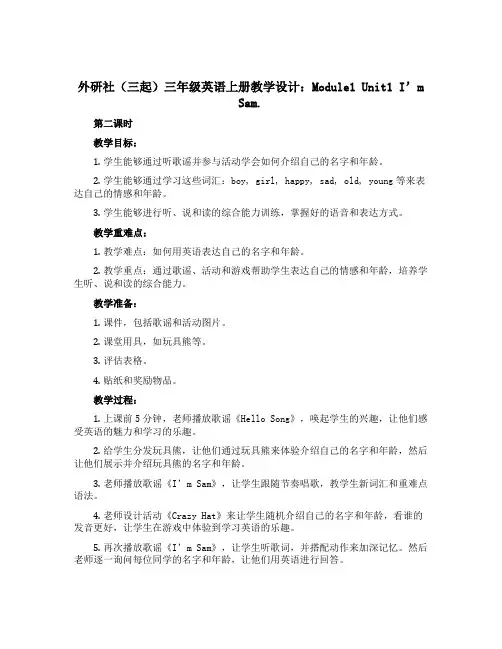
外研社(三起)三年级英语上册教学设计:Module1 Unit1 I’mSam.第二课时教学目标:1.学生能够通过听歌谣并参与活动学会如何介绍自己的名字和年龄。
2.学生能够通过学习这些词汇:boy, girl, happy, sad, old, young等来表达自己的情感和年龄。
3.学生能够进行听、说和读的综合能力训练,掌握好的语音和表达方式。
教学重难点:1.教学难点:如何用英语表达自己的名字和年龄。
2.教学重点:通过歌谣、活动和游戏帮助学生表达自己的情感和年龄,培养学生听、说和读的综合能力。
教学准备:1.课件,包括歌谣和活动图片。
2.课堂用具,如玩具熊等。
3.评估表格。
4.贴纸和奖励物品。
教学过程:1.上课前5分钟,老师播放歌谣《Hello Song》,唤起学生的兴趣,让他们感受英语的魅力和学习的乐趣。
2.给学生分发玩具熊,让他们通过玩具熊来体验介绍自己的名字和年龄,然后让他们展示并介绍玩具熊的名字和年龄。
3.老师播放歌谣《I’m Sam》,让学生跟随节奏唱歌,教学生新词汇和重难点语法。
4.老师设计活动《Crazy Hat》来让学生随机介绍自己的名字和年龄,看谁的发音更好,让学生在游戏中体验到学习英语的乐趣。
5.再次播放歌谣《I’m Sam》,让学生听歌词,并搭配动作来加深记忆。
然后老师逐一询问每位同学的名字和年龄,让他们用英语进行回答。
6.在教室里贴上“HAPPY”和“SAD”的海报,让学生询问同伴的情感及其原因,并表达自己的情感。
引导学生运用自己学习的单词和句子来表达情感和年龄。
7.最后,老师进行小结和评估,让学生用自己的名字和年龄来写一句话,并让学生进行主观评估。
展示方法:1.听歌谣和活动。
2.看图片和玩具熊。
3.互动交流和活动。
4.学生口头表达和写作。
评估方式:1.课后布置写作作业,要求学生能用英语表达自己的姓名和年龄。
2.通过观察学生的口语表达和参与活动的表现来检查他们是否掌握了教学要求。
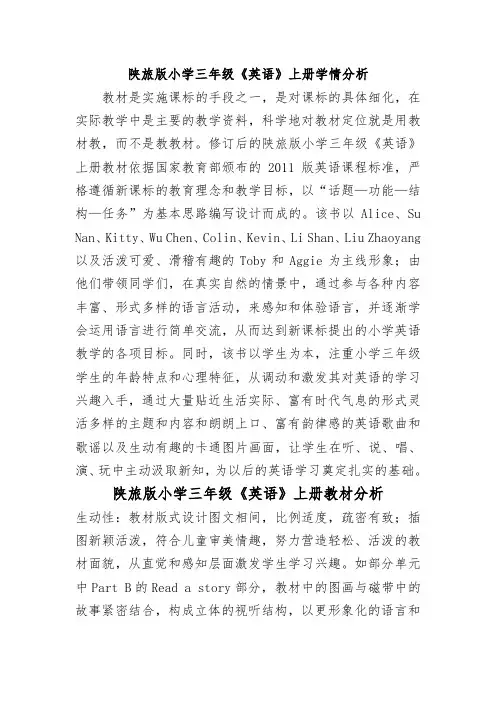
陕旅版小学三年级《英语》上册学情分析教材是实施课标的手段之一,是对课标的具体细化,在实际教学中是主要的教学资料,科学地对教材定位就是用教材教,而不是教教材。
修订后的陕旅版小学三年级《英语》上册教材依据国家教育部颁布的2011版英语课程标准,严格遵循新课标的教育理念和教学目标,以“话题—功能—结构—任务”为基本思路编写设计而成的。
该书以Alice、Su Nan、Kitty、Wu Chen、Colin、Kevin、Li Shan、Liu Zhaoyang 以及活泼可爱、滑稽有趣的Toby和Aggie为主线形象;由他们带领同学们,在真实自然的情景中,通过参与各种内容丰富、形式多样的语言活动,来感知和体验语言,并逐渐学会运用语言进行简单交流,从而达到新课标提出的小学英语教学的各项目标。
同时,该书以学生为本,注重小学三年级学生的年龄特点和心理特征,从调动和激发其对英语的学习兴趣入手,通过大量贴近生活实际、富有时代气息的形式灵活多样的主题和内容和朗朗上口、富有韵律感的英语歌曲和歌谣以及生动有趣的卡通图片画面,让学生在听、说、唱、演、玩中主动汲取新知,为以后的英语学习奠定扎实的基础。
陕旅版小学三年级《英语》上册教材分析生动性:教材版式设计图文相间,比例适度,疏密有致;插图新颖活泼,符合儿童审美情趣,努力营造轻松、活泼的教材面貌,从直觉和感知层面激发学生学习兴趣。
如部分单元中Part B的Read a story部分,教材中的图画与磁带中的故事紧密结合,构成立体的视听结构,以更形象化的语言和场景相结合让学生巩固所学知识内容,以培养学生学英语的兴趣、信心、策略和习惯为根本出发点,为学生英语能力的持续发展打下坚实的基础。
趣味性:教材中安排了节奏明快的chant、具有较强感染力的英文歌曲、走迷宫、涂颜色等教学内容,听、说、做、玩、唱、演的内容安排,使表现形式丰富多样,既富于情趣,又能开发学生智力。
交际性:教材从切实培养儿童语言实践能力考虑,设计了完整的语言情景,给学生提供了直接的交际素材。
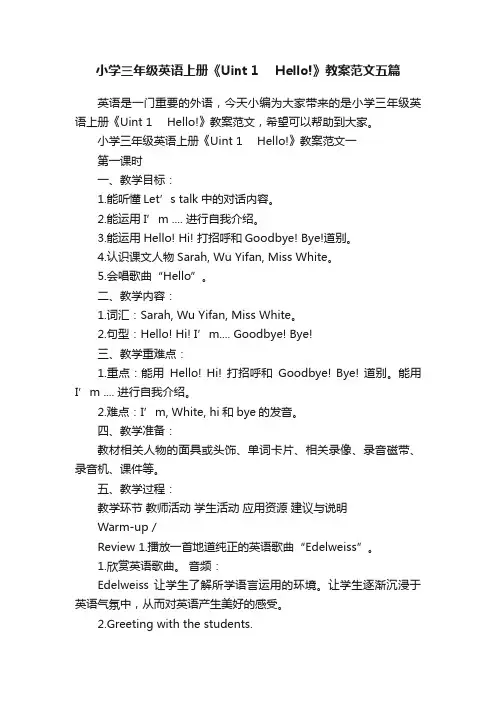
小学三年级英语上册《Uint 1 Hello!》教案范文五篇英语是一门重要的外语,今天小编为大家带来的是小学三年级英语上册《Uint 1 Hello!》教案范文,希望可以帮助到大家。
小学三年级英语上册《Uint 1 Hello!》教案范文一第一课时一、教学目标:1.能听懂Let’s talk中的对话内容。
2.能运用I’m .... 进行自我介绍。
3.能运用Hello! Hi! 打招呼和Goodbye! Bye!道别。
4.认识课文人物Sarah, Wu Yifan, Miss White。
5.会唱歌曲“Hello”。
二、教学内容:1.词汇:Sarah, Wu Yifan, Miss White。
2.句型:Hello! Hi! I’m.... Goodbye! Bye!三、教学重难点:1.重点:能用Hello! Hi! 打招呼和Goodbye! Bye! 道别。
能用I’m .... 进行自我介绍。
2.难点:I’m, White, hi和bye的发音。
四、教学准备:教材相关人物的面具或头饰、单词卡片、相关录像、录音磁带、录音机、课件等。
五、教学过程:教学环节教师活动学生活动应用资源建议与说明Warm-up /Review 1.播放一首地道纯正的英语歌曲“Edelweiss”。
1.欣赏英语歌曲。
音频:Edelweiss 让学生了解所学语言运用的环境。
让学生逐渐沉浸于英语气氛中,从而对英语产生美好的感受。
2.Greeting with the students.操练Class begins. Stand up.Sit down, please. 2.Greeting with the teacher.学生听指令做相应的动作。
让学生初步了解课堂指令。
使学生从一开始学习英语就熟悉课堂用语及指令。
3.游戏“反动作”。
教师说指令Stand up.学生即做Sit down.的动作。
当教师说Sit down.的指令时,学生即做Stand up.的动作。
The second period(第二课时)Part A Let’s learn & Let’s chant▶教学内容与目标课时教学内容课时教学目标Let’s learn ·能够听、说、认读四个文具类单词“ruler, pencil, crayon, eraser”·能够通过多种活动运用句型“I have a/an…”来表达自己拥有某物Let’s chant ·能够在图片、动作和音频的帮助下理解并跟读歌谣·能够理解“Me too!”的意思并在实际情景中运用▶教学重点能够理解和掌握本课重点单词“ruler, pencil, crayon, eraser”。
▶教学难点能够在情景中运用句型“I have a/an…”来表达自己拥有某物。
▶教学准备教学课件、课文录音、视频、人物头饰、教学实物、图片等。
▶教学过程Step 1: Warm-up & Revision①1 Greetings.2 Sing and dance.T: Can you sing the song we learned last class? OK, let’s sing and dance together. (课件出示:教材P10 Let’s sing板块的歌曲)3 Revision.The teacher asks some students to wear different headdresses and introduce themselves. The other students say “Hello/Hi, …”S1:Hello, I’m…Ss:Hi, …T:Before the class, I’ll divide you into four groups.Let’s make a competition! Try to get more stars!Step 2: Presentation1. Learn the new words.②(1) Teach the word “ruler”.The teacher takes out a pencil box. Teaching purpose①课前问好,拉近与学生的距离。
三年级上册英语教案- Unit1 第2课时∣人教新起点一、教学目标1.掌握单词:apple、banana、grape、orange、pear、watermelon;2.掌握句型:What fruit do you like?- I like+ 水果词汇;3.能够熟练运用所学单词和句型进行基本的口语交流。
二、教学内容1.学习本课中的6个水果单词,掌握它们的英文发音和汉语意思;2.学习表达自己喜欢的水果是什么,以及问别人喜欢的水果是什么的句型。
三、教学重难点1.掌握6个水果单词的英文发音和汉语意思;2.能够熟练问别人喜欢吃什么水果,并回答自己喜欢什么水果。
四、教学准备1.PPT课件;2.教学道具:水果模型或图片。
五、教学步骤1. Warming up1.Greeting: 教师和学生互相问候;2.热身活动:Let’s sing a song about fruits。
2. Presentation1.学习新单词:教师出示水果图片或模型,学生跟着认读单词,教师纠正发音错误,并帮助学生理解单词的意思;2.多媒体演示:教师使用PPT展示有关各种水果的图片,帮助学生加深对单词的印象。
3. Practice1.学生自我介绍:学生用所学的句型介绍自己喜欢的水果;2.练习问答句型:What fruit do you like?- I like + 水果词汇。
4. Production1.组织学生到教室后面摆放的水果区域,让学生通过观察和品尝来感知、体验水果;2.调查活动:学生向同桌或其他学生问:What fruit do you like?并记下同学们的不同回答。
5. Homework为了巩固本节课所学知识,布置如下家庭作业:课后认真复习本课所学的单词、句型,并尝试使用所学知识去问家人或朋友他们喜欢什么水果。
六、教学反思本节课以水果为话题,通过教授单词、句型、实际体验等多种方式,让学生在情境中学习英语,激发学生学习兴趣,增强了学习新知识的积极性。
《PEP英语》小学英语三年级上册Unit 6 Part A Let’s learn & Let’s do(第一课时)——小学英语空中课堂教学案例一、案例背景分析1、教学内容:A Let’s learn Let’s do2、教学目标:⑴通过动物玩具引出数字卡片1-10,并学会与其相应的英语表达法。
⑵组织小组活动,能用英语表达自家的电话号码,学会在真实的语言环境中学习。
⑶通过已学有关数字的古诗,配对练习贴词卡,有效实施学科之间的整合和渗透。
3、教学重点与难点教学重点:让学生能听、说、认读1-10的数字单词。
教学难点:1-10的指令活动(Let’s do)4、教学策略⑴教具准备:代表4个组的动物头饰、《小学英语空中课堂》光碟、多媒体、词卡及实物教具。
⑵教学方法:《英语空中课堂》演示、游戏、情景创设和交际活动。
二、教学媒体设计本节课可利用《英语空中课堂》的有效资源。
学生们坐在宽敞明亮的教室里,看着精彩有趣的空中英语,通过视听说给予孩子们焕然一新的感觉。
自复习开始到通过已学的动物来引出本课的教学内容——数字1-10,这一整个《英语空中课堂》的环节,可有效利用。
《英语空中课堂》采用动物们自报序号,一个一个展现出来,最后组合成了一个小小的动物乐园,生动活泼,切合实际。
当孩子们跟着小动物们学完了1-10的英文数字及手势动作后,这之间授课老师可自由发挥。
接着自Let’s do部分至小结处,此一环节也可直接利用《英语空中课堂》,将本节课收尾。
总之,《英语空中课堂》将重点和难点以新颖活泼的方式呈现了出来,直观明了。
如何复习,新课的导入,它都给予了总体的指导。
新知识的巩固和操练,《英语空中课堂》给授课教师留足了时间,它实在是一个好的可利用的再生资源。
三、教学过程Step1: GreetingsStep2: Warm-up/ Revision(《小学英语空中课堂》展示)[设计思路及资源应用分析]本课复习及导入完全可利用《英语空中课堂》,因为它比较详尽而细致地复习了同学们在Unit 4里已学过的有关动物的单词及其行为动作。
三年级上册英语教案-module1Unit 1外研社(一起)一、教学目标1. 知识目标1.学习认读26个小写字母和3个大写字母;2.能用正确的发音念出26个字母的名称;3.能听懂、会应答日常交际用语。
4.复习并掌握问候语。
2. 能力目标1.训练学生听、说、读英语的能力,培养其初步的英语交际能力;2.培养学生的观察能力,注意力和快速反应能力;3.通过听说读的方式培养和提高学生的英语综合语言运用能力。
3. 情感目标1.培养学生对英语的兴趣;2.发扬团结合作精神,促进同学之间的交往和帮助,在积极向上的课堂氛围中学习。
二、教学重点1.认读26个小写字母和3个大写字母;2.能用正确的发音念出26个字母的名称;3.能听懂、会应答日常交际用语。
三、教学难点1.能听懂、会应答日常交际用语。
四、教学准备1.教师准备课桌和黑板;2.视频或课件;3.口语表和物品。
1. 创设情境,导入新课1.利用视频和课件,让学生熟悉26个字母,掌握它们的发音和写法,并有些许练习。
2. 学习新课A. 学习单词:1.apple2.boy3.car4.dogB. 听力练习:1.根据老师的描述,学生回答问题,如What’s this? It’s an apple.C. 复习问候语1.Good morning/afternoon/evening2.How are you?3.(I’m)Fine, thank you. / Not good.D. 练习问答句子1.例子:•A: Good morning.•B: Good morning.2.见到陌生人询问姓名,如:•A: What’s your name?•B: My name is Mike.3. 小结1.复习26个字母,会写出字母的名称,并掌握它们的发音;2.认识4个单词,并能听懂和说出这些单词;3.能听懂、会应答日常交际用语。
本节课教学模式较为单一,主要以听说为主,评价标准也较简单明确。
在教学中,同桌认读英文字母时部分学生认读困难。
冀教版三年级英语上册教案5篇冀教版三年级英语上册教案1Step 4 Homework .Listen to the tape four times .( A Learn to say )Design :Unit 10 Do you play…Yes ,I do .No, I don’t .What do you play ? I play the …The second periodTeaching Contents:A.Vocabulary : football ,volleyball, baseball ,basketball .B.Patterns:Do you like …?Yes ,I do /No ,I don’t .Teaching Aims:能听懂、会说球类单词football,volleyball,baseball,basketball.能听懂、会说日常交际用语Do you like…? Yes ,I do /No ,I don/t .会唱歌曲We study and play .Teaching Steps:Step1 Warm upSay a rhyme:Jack has a clock .Sing a song: Hot cross buns .Step2 Free talk and presentation .Free talk .e.g T: Do you play the piano ?S1: Yes ,I do ./No ,I don’t .T: What do you play ?S1: I play the violin .Do you play the violin ?S2: Yes ,I do …S3:…Presentation .教师出示一个足球,T:I like football.(边说边踢球,当球滚到一学生跟前时,师提问)T:Do you like football? Yes or no ? (教师引导学生回答)S:Yes ,I do /No ,I don’t .学生自由组合练习对话。
三年级英语上册Unit1 Number教案
三年级英语上册Unit1Number教案
教学内容
Unit1Number
教学目标
语言知识
A.
听、说、认读six
cansofsoftdrink,sevenchocolatebars,fourpacketsofcri sps
等短语。
语言技能
能够用简单的英语互相问答
Ieat……
He
eats……
学习策略
注重合作学习,鼓励学生创新,尝试各种人称的用法。
情感态度
教育学生要学会团结,合作。
文化意识
了解英国的文化
教学重点和难点
重点:听、说、认读six
cansofsoftdrink,sevenchocolatebars,fourpacketsofcri sps
等短语。
难点:Ieat……句型用法。
班级情况分析
五年级的全体学生
教学评价设计要点
本节课主要采用口头评价,奖励小帖画,以及大组以画笑脸的形式进行评价
教学过程:
Step1
warming—up(激情导入)
,Freeing.
2,Say
chant
Step2Presentation(民主导学)
,a,Teacher
takes
the
picture.
T:I
likesoftdrinks.
whatabout
you?
S:
b,Readafter
me.
2,同样的方法教学chocolatebars,fourpacketsofcrisps.
3,Lookattheblackboard.Readthem.
3,Read
the
words.
4,T:Hi,I’mmisswang.Ilive
inyuci.whatabout
you?
S:
5,openyour
booksatpage
32.Lookatpart10.Read
thetextyourselves.
Step3
Practice
,,Read
the
text.
2,Read
after
thetape.
3,Read
after
the
teacher
4,In
pairpractice.
5,checkthestudents.
6,T:ThisisTony,Heis……. S:
Step4
Part11(检测导结)
,T:ThisisSue.
Shelikes
apples,bananasandoranges T:Howmanybananas?
2,Lookand
write.
3,Read
it.
Step4Homework
,complete
the
word
puzzle
2,Listen
and
talk.
板书设计:
Unit3
School
threecans
of
softdrinks
I
eat……Heeats……
chocolatbars two
packets ofcrisps。